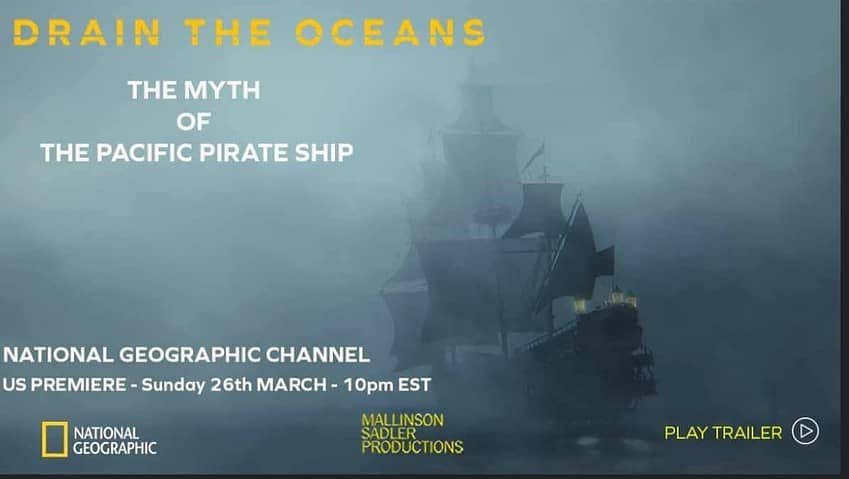EDITOR’S NOTE: I first met Craig Andes in 2014 when he contacted me about doing a story. His home was covered in maps and artifacts and I’ve been following his search ever since. His knowledge about the area, the history and determination to share his discovery was infectious. Fast forward to 2022 … described in other stories as a “local fisherman” Craig Andes is much more than a fisherman. He is a local historian/treasure seeker and scholar, studying the local geologic history and seeking out pieces of one of many shipwrecks that rest off the Pacific Coast. In his own words below, Craig’s story and warnings about treasure-seeking and safety. The various media outlets have played up the “Goonies” theme, but really the only similarity is that some of the ship beams were discovered in a sea cave. Craig is still out there looking for more evidence of this ship and others. Check out some of the National Geographic photos (you’re sure to see some familiar faces!)
Be sure to tune in tomorrow March 26th to Nat Geo’s “Drain the Oceans” for a feature on the Mystery of the Pacific Pirate Ship.
In his own words – from Craig Andes: “I have wanted to share what I found with the local community a long time ago but a few officials thought it should be kept a secret. I understand where they are coming from – a safety standpoint but people are looking for things on our beaches and doing dangerous things everyday all along the coast. Trying to censor the location will just lead people to other dangerous locations they may get hurt at and a location that officials may not be keeping as much watch over. People need to be smart about their surroundings on our coast. The ocean does not care about you! Even if you care about it which we all should. If you are not extremely confident in your abilities and even should have the proper safety gear when exploring the coastal waters, DO NOT GO in sea caves or under rock overhangs. Do not cause first responders to have to save or help you because of unsafe unplanned risky actions. I run a commercial dive operation and have been working in extreme swift water conditions for years and I know my limits. AND WATCH THE TIDES AND WEATHER. Everybody should consider when doing something extreme – like visiting all our sea caves on our coast. Be safe exploring and enjoying the Oregon coasts amazing beaches. If you find something you think is old on the beaches record it with your phone and call someone official like Scott Williams or Maritime Archeological Society (MAS) and get your name in the papers. I want to see a program in place by the state so that when people find small bits of the wreck that are no longer in situ and moving around daily I feel they should be collected and submitted to be recorded and then returned to the finder because for the next 300 years there will be bits of porcelain washing up our beaches from possibly several wrecks in the area. The situation here with the wreck could and will inspire and allow many generations of beach explorers to participate in unraveling one of Oregon’s most enigmatic coastal mysteries.
Tomorrow, Sunday March 26th at 10 pm (Pacific Time) on NatGeo “Drain the Oceans” will feature “The Myth of the Pacific Pirate Ship” which details Craig’s discoveries and speculates about where more of the shipwreck might be off the North Oregon Coast. Here’s a trailer for the program:
Here is the National Geographic feature story
Legendary Spanish galleon shipwreck discovered on Oregon coast
In 1693, a ship carrying silk and beeswax from the Philippines to Mexico mysteriously vanished. Now a risky mission has recovered its timbers—solving a 300-year-old puzzle.
Archaeologists, law officers, and search-and-rescue personnel execute the risky emergency recovery of 17th-century shipwreck timbers from the Oregon coast earlier this week. They are believed to belong to the Santo Cristo de Burgos, a Spanish galleon that disappeared en route from the Philippines to Mexico in 1693.
BY KRISTIN ROMEY
PHOTOGRAPHS BYBALAZS GARDI
(PUBLISHED JUNE 16, 2022 ASTORIA, OREGON) – Timbers from the wreck of a 17th-century Spanish galleon have been discovered on Oregon’s northern coast, state officials confirmed today.
The extraordinarily rare hull remains were removed from sea caves near Manzanita earlier this week in a risky emergency recovery mission involving archaeologists, law enforcement personnel, and search-and-rescue teams from multiple state and local agencies.
“I’m impressed and relieved,” says Scott Williams, an archaeologist with the Washington State Department of Transportation and president of the Maritime Archaeology Society (MAS), an all-volunteer group that spearheaded a 15-year search for the shipwreck.
The dozen timbers are believed to be pieces of the Santo Cristo de Burgos, a Spanish galleon that was sailing from the Philippines to Mexico in 1693 when it veered off course and vanished, most likely wrecking on what’s now Oregon’s coast. Its cargo included costly Chinese silk, porcelain, and blocks of beeswax for making candles.
Fabled lost ship found way off course
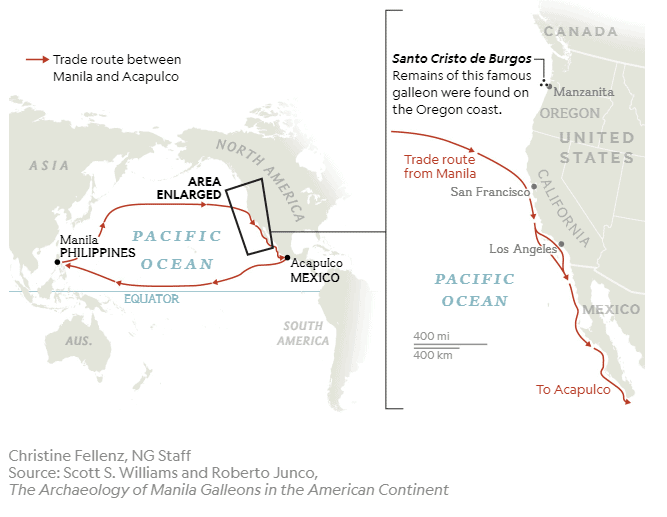
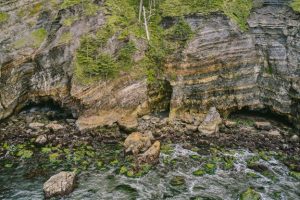
Spanish galleons began sailing between the Philippines and Mexico in 1565 and traded goods for 250 years. The Santo Cristo de Burgos disappeared after leaving the Philippines in 1693. The shipwreck location has been confirmed hundreds of miles from the traditional galleon route.
The rugged shoreline of Oregon’s north coast, strong swells, and treacherous storms all make for a landscape hostile to centuries of navigators.
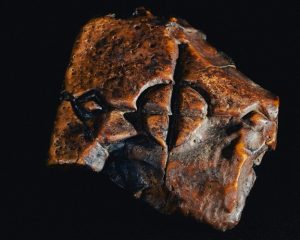 A block of beeswax from the Santo Cristo de Burgos features a distinctive owner’s mark.
A block of beeswax from the Santo Cristo de Burgos features a distinctive owner’s mark.
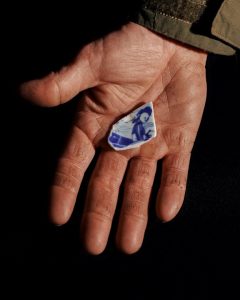 Bits of Chinese porcelain from the Kangxi period (1661-1722) that washes ashore near Manzanita are likely remnants of the galleon’s cargo.
Bits of Chinese porcelain from the Kangxi period (1661-1722) that washes ashore near Manzanita are likely remnants of the galleon’s cargo.
Santo Cristo de Burgos was a Manilla galleon, a type of sturdy wooden vessel that plied an annual trade route between Spanish colonies in the Philippines and Mexico from 1565-1815, a period that marked the first era of global trade. The workhorse European ships were built in Asian ports by Asian craftspeople using Asian materials.
Despite their 250-year run—and the inevitable loss of wooden vessels crossing the hazardous Pacific—remarkably few Manilla galleon shipwrecks have been found. Only three are known from the west coast of the Americas—with one each in Oregon, California, and Baja Mexico—and no surviving hull remains have been discovered until now.
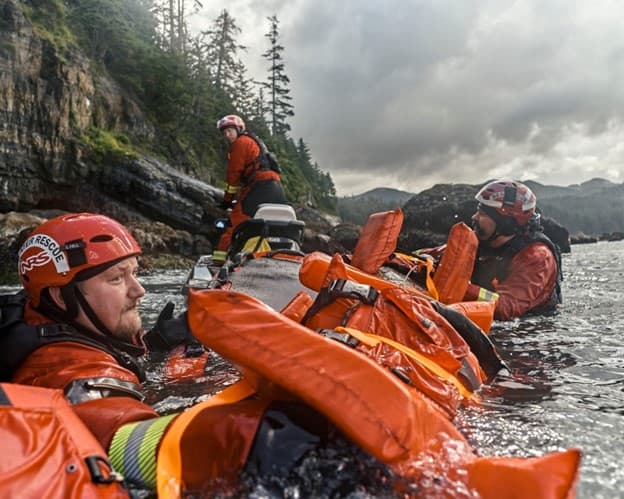
Telltale signs of a sunken ship
The Santo Cristo is better known along the Oregon coast as the legendary “Beeswax Wreck”—a moniker derived from distinctive blocks of beeswax that washed ashore for centuries and were traded by local Native American tribes and later Anglo-European settlers. Because honeybees are not native to the Americas—they were imported from Europe in the 17th century—Asian beeswax was a major import for Spain’s colonies, where beeswax candles were required for Catholic services.
There were other clues that a shipwreck lay hidden somewhere offshore, from small bits of blue-and-white porcelain to large pieces of wood tossed up on the rocks or buried in the shifting sand. A section of the upper deck of a wooden ship was visible at the mouth of a river near Manzanita until about the 1920s. And oral histories from the area’s Indigenous tribes tell of a foreign ship that wrecked long ago, with a crew that came ashore and met varying fates.
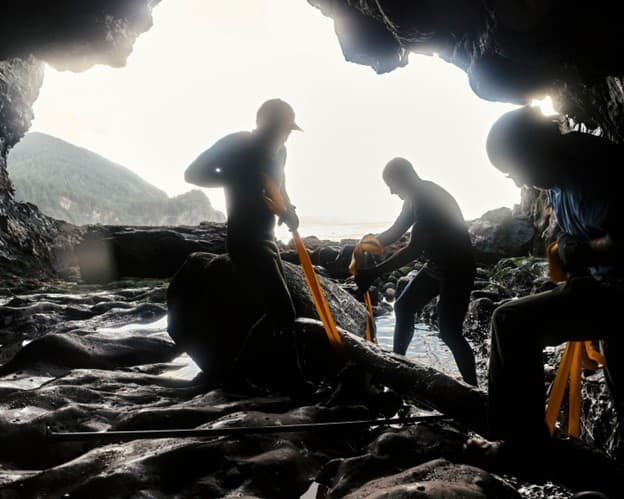
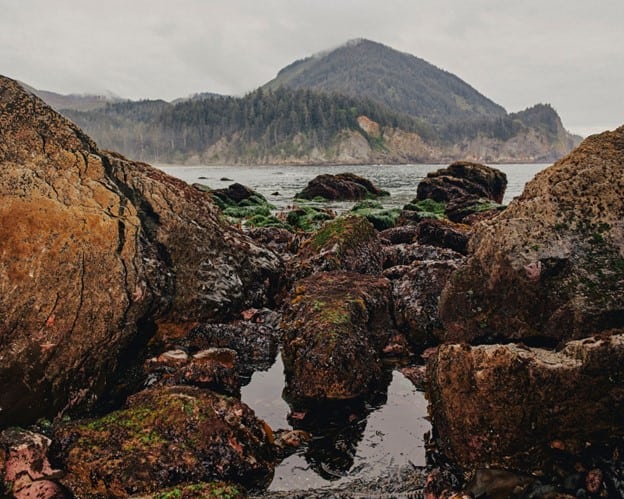 Neahkahnie Mountain near Manzanita is called the “Mountain of 1,000 Holes” after more than a century of treasure-seekers dug without success for the riches rumored to be hidden within its slopes. Stories of shipwrecks and treasure play a prominent role in Oregonian coastal lore.
Neahkahnie Mountain near Manzanita is called the “Mountain of 1,000 Holes” after more than a century of treasure-seekers dug without success for the riches rumored to be hidden within its slopes. Stories of shipwrecks and treasure play a prominent role in Oregonian coastal lore.
The discovery of the galleon’s remains “confirms that our ancestral people knew what they were talking about,” says Robert Kentta, cultural resources director for the Confederated Tribes of the Siletz and a member of the Siletz Tribal Council. “They related oral histories in a way that just spoke the truth.”
As white settlers came to this dramatic, craggy coast, the Native American accounts became embroidered with increasingly fantastic tales of hidden riches. By the late 20th century, local legends of treasure and galleons—and the hunt for them—appeared regularly in the pages of Oregon newspapers. Those reports caught the attention of filmmaker Steven Spielberg and likely inspired his idea for the 1985 film The Goonies, a Gen-X cult tale of treasure-seeking kids and a mystery galleon on Oregon’s wild Pacific coast.
But for all the talk of treasure, there were two glaring questions: Where—and what—exactly was the Beeswax Wreck?
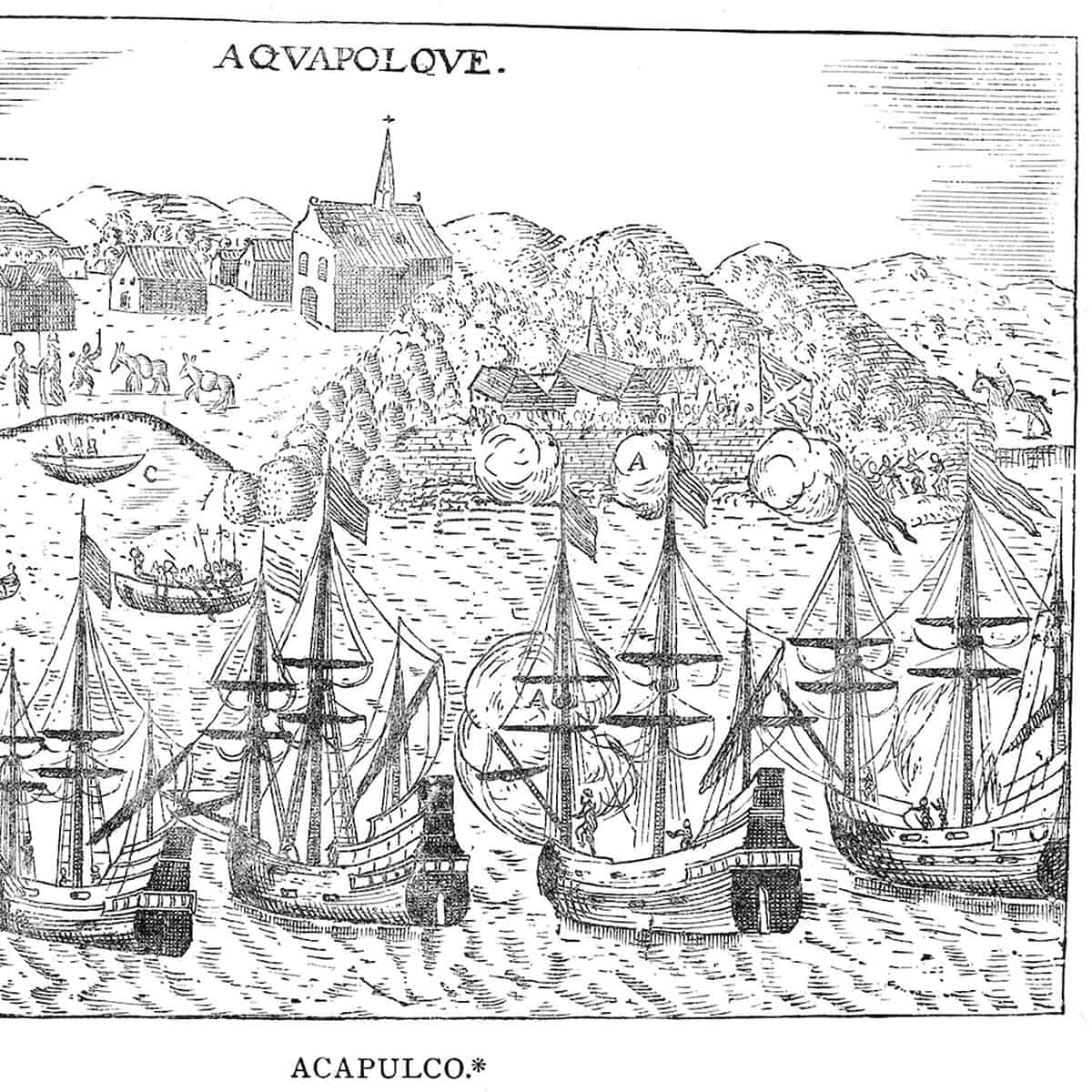
A German engraving from 1620 shows Spanish galleons in the Pacific port of Acapulco. The annual Manilla galleon trade between Philippines and Mexico between 1565 and 1815 marked the first era of truly global trade.
Secrets from a tsunami
In the mid-2000s, a group of researchers and community members including Williams decided to answer that question, eventually forming the Maritime Archaeology Society (MAS). They studied thousands of pieces of Chinese porcelain collected by beachcombers over the years and determined they were from the Kangxi period (1661-1722).
The Chinese ceramics and Asian beeswax blocks with Spanish markings led them to conclude that the Beeswax Wreck had to be one of two Manilla galleons that went missing between roughly 1650 and 1750: the Santo Cristo de Burgos, which was lost in 1693, or the San Francisco Xavier, which disappeared in 1705.
At first, the archaeologists suspected that the Beeswax Wreck was the 1705 San Francisco Xavier—and with good reason. In 1700, a 9.0-magnitude earthquake struck the West Coast, trigging an enormous tsunami. If the Santo Cristo had wrecked in the area, they reasoned, the tsunami that swept the coast just a few years later would have destroyed anything that was left.
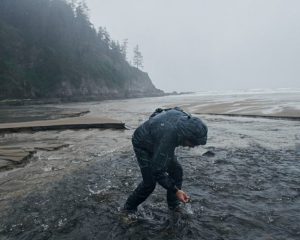
Then a geological study revealed something surprising: The area near the Nehalem River where beeswax, porcelain, and pieces of a wooden ship had been found was under and within—not above—the sediment layer left by the estimated 25-foot-high wave that struck the coast. This meant that the mystery shipwreck must have already been there when the tsunami hit in 1700. But was it the Santo Cristo de Burgos?
A catalog of Spanish ships published in the 1930s—a source still widely consulted by archaeologists—claimed that, according to Spanish records, the Santo Cristo burned somewhere in the middle of the Pacific. But the volunteer group raised money to fund research in Spain’s exhaustive naval archives, which eventually told a different tale: Despite a multi-year search by the Spanish crown, Santo Cristo de Burgos had simply vanished.
MAS researchers were then fairly confident that the Beeswax Wreck and the Santo Cristo de Burgos were one and the same vessel. But identifying the shipwreck’s whereabouts would prove even more challenging. For the all-volunteer MAS, it meant diving and surveying in their free time in difficult conditions that could change in an instant.
By 2019, their remote-sensing tools had detected a few objects off the coast near Manzanita that might be the remains of a wooden ship—or just an odd boulder on the seafloor. Yet despite the absence of conclusive evidence, the wreck of the Santo Cristo had to be somewhere offshore, they reasoned, for it had sent a steady stream of beeswax and porcelain ashore for generations of beachcombers to discover and ponder.
Growing up Goonies
Craig Andes is one of those beachcombers, a commercial fisherman who belonged to a “Goonies gang” of kids who grew up exploring the coast, inspired by tales of treasure. He began sharing his knowledge of the area’s artifacts with MAS after reading about their hunt for the Beeswax Wreck.
That information included the presence of bits of wood in sea caves that Andes first spotted in 2013. He kept a watchful eye on them and strongly believed they were ship timbers. He also grew concerned that the smaller pieces were at risk of being washed away. So in 2020 he contacted the MAS and urged them to test a sample of the wood.
“I was convinced it was driftwood,” MAS president Williams recalls. “To think that 300-year-old ship timbers could survive the Oregon coast was just crazy.”
A lab analysis revealed that the timbers were hewn from Anacardiaceae, a species of tropical hardwood found in Asia. Radiocarbon dating indicated that the tree was felled around 1650. Both facts lined up squarely with the composition and age of the Santo Cristo.
During the summer of 2020, MAS archaeologists investigated the caves—reachable only by water or a perilous scramble over rocks at extremely low tides—and determined that the timbers were a “secondary deposit,” meaning they were not part of a shipwreck site but had been washed into the cave, possibly by the 1700 tsunami.
The archaeologists also agreed that the timbers were at risk of being swept out to sea, but extracting them from the sea cave would be complicated and dangerous. They would have only about 90 minutes to document and remove the timbers before the tide would rise and trap them. Since the recovery could be safely done only by an expert team during an unusually low tide, they enlisted SEARCH Inc., a cultural resource management firm, to coordinate the mission. The project would be funded in part by a grant from the National Geographic Society.
A dangerous recovery
After a year of delays caused by the COVID-19 pandemic and unpredictable weather, a few dozen people assembled at sunrise this week on an empty beach to recover the remains of the Santo Cristo de Burgos. Personnel from the Tillamook and Clatsop Counties Sheriff’s Offices joined archaeologists from Oregon Parks and Recreation Department, MAS, and SEARCH Inc., in the risky scramble to the sea cave. Rescue swimmers from the Nehalem Valley Fire Department circled on jet skis, while ropes teams monitored the operation from the cliffs above.
The sun rises on a June morning on Oregon’s Pacific Coast. While the timber discovery has confirmed these are the likely remains of the Santo Cristo de Burgos, archaeologists will continue to search for other parts of the wreck that may remain offshore.
The timbers were recovered safely and intact, and the team felt a palpable sense of relief. “It was amazing to pull off such a complex operation, made entirely possible by teamwork, cooperation, and exceptional professionalism by all involved,” says Jim Delgado, the project’s principal archaeological investigator and senior vice president at SEARCH Inc.
Andes watched the activity from the beach, marveling at the complicated choreography. Nearly a decade had passed since he spotted the timbers, and as the first, and largest, piece was towed ashore, he ran his hand appreciatively along the glistening surface and reveled in the culminating moment.
The timbers are now at the Columbia River Maritime Museum in Astoria, where they’ll be carefully documented and conserved. Each timber will be scanned in detail, and the scans will be shared with Manilla galleon experts around the world to better understand how the extraordinary ships were built.
But the small collection of unassuming wood is not just a source of information about Manilla galleons, says Delgado. “These timbers are also the physical evidence for the stories that have been known and passed down through generations.”
Chris Havel, spokesperson for the Oregon Parks and Recreation Department, says the agency is looking forward to learning what researchers discover about the recovered timbers, “so we can share that news with the people who visit our parks.” But he also cautions people not to risk their lives attempting to visit the now-empty sea caves.
“Visitors should respect any signs or warnings you may see, and refrain from searching for artifacts or taking anything away from our parks other than the memories of a fun, safe visit.”
The source of the beeswax and porcelain that still washes up along the coast remains somewhere offshore, and MAS will continue its underwater hunt for more remains of the Santo Cristo de Burgos.
Meanwhile, Williams urges local community members to keep their eyes out for any “smoking gun” that could confirm the identity of Oregon’s fabled galleon, such as a coin, or any item that bears a date or name.
“Somebody could have it in the attic or their basement,” he says. Or a lucky beachcomber might turn up a decisive bit of evidence after a big storm—”if someone just looks down in the right place.”
Here’s a link to the National Geographic story – https://www.nationalgeographic.com/history/article/legendary-spanish-galleon-shipwreck-discovered-on-oregon-coast?fbclid=IwAR3nWs861DlZGt42dqZCTJRhmYBOCF05ehcljl3ZWQ3zigYQq7qHH-MvW-o
Balazs Gardi is a Hungarian-born photographer whose work explores man-made conditions that threaten humanity’s existence. He has covered the war in Afghanistan and the far-reaching consequences of the global water crisis. His work has been honored with the Bayeux-Calvados Award for War Correspondents and the Global Vision Award from Pictures of the Year International. To see more of his work, follow him on Instagram.
Kristin Romey is National Geographic’s senior archaeology writer and editor. Follow her on Twitter.
If you spot something on the Oregon coast that you think may be of archaeological or cultural importance, here’s what you should do. Read more local coverage on the discovery of the Santo Cristo de Burgos from Oregon’s Astorian newspaper.

